2020年分子生物学的中心法则参照模板
分子生物学基础

分子生物学基础
b.专一性终止蛋白 E.coli 中由 tus gene 编码 通过抑制DNA螺旋酶而发挥终止作用
ter
分子生物学基础
分子生物学基础
4、DNA损伤与修复 • 光复活 • 切除修复 • 重组修复 • SOS修复
分子生物学基础
(一)photo reactivation(光复活)
2、半保留复制 3、半不连续复制 4、DNA复制具有高度的忠实性
DNA聚合酶的自我校正功能
5、多种酶和蛋白因子协同作用
分子生物学基础
1,复制起点
分子生物学基础
θ 复制或重新起始( de novo initiation )或复制 叉式( replication fork )
双链环状DNA的复制眼可以形成一种θ结构,形 状像希腊字母θ
分子生物学基础
1)、与转录调控有关的DNA序列
• -10区pribnow框(TATAAT):RNA聚合酶的牢固 结合位点
• -35区Sextama框(TTGACA):RNA聚合酶的识别 位点
• 一般来说,对于给定的启动子,其特异性序列趋于启动子 共有序列时-10与-35区之间的间距趋于17bp时,启 动子的转录效率可能就高
• 真核基因:
1、复杂的染色体结构:着丝点、 端粒,与DNA复制起点一起构成 染色体不可缺少的三要素
2、DNA重复顺序 重复序列的存在是真核生物 DNA区别于原核生物DNA的一 个重要特征
分子生物学基础
3、基因的不连续性 (外显子、内含子)
4、真核生物基因组中有许多来源相 同、结构相似、功能相关的基因组成 为单一的基因簇或基因家族(gene Family) Alu序列家族
定位 转录产物 α-鹅膏蕈 碱的影响
生物信息学4分子生物学中心法则
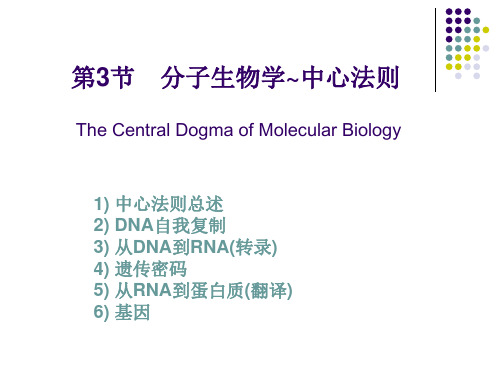
(large ribosomal subunit) (large ribosomal subunit)
原核生物的核糖体为70S,由50S和30S的大小亚基组成; 真核生物的核糖体为80S,由60S和40S的大小亚基组成。
Ribosome structure
P PP
Large subunit(60S) P P P P P A A-site aminoacyl tRNA site
RNA
类型 mRNA 信使RNA
tRNA 转运RNA
结构 单链;原核生物的mRNA为 多顺反子,真核生物的为单 顺反子。
二级结构是三叶草型结构; 三级结构为倒L型结构。
作用 DNA原始遗传信息的直接接受者;合 成蛋白质直接模板。
转运氨基酸到核糖体上;通过反密码 子识别mRNA上的密码子。
rRNA 16S (small ribosomal 核糖体RNA subunit) 23S (large ribosomal subunit) 5S (large ribosomal subunit)
Peptide bond formation
P-site
A-site
NH2 CH3-S-CH2-CH2-CH C O=C O tRNA
N 2 NH CH3-CH O=C O
tRNA
A-site NH2 CH3-S-CH2-CH2-CH • peptide bond formation is catalyzed O=C by peptidyl transferase(肽基转移酶) NH CH3-CH • peptide bond formation results in a shift P-site of the nascent peptide from the P-site O=C to the A-site OH O tRNA tRNA
高二生物知识点总结:中心法则
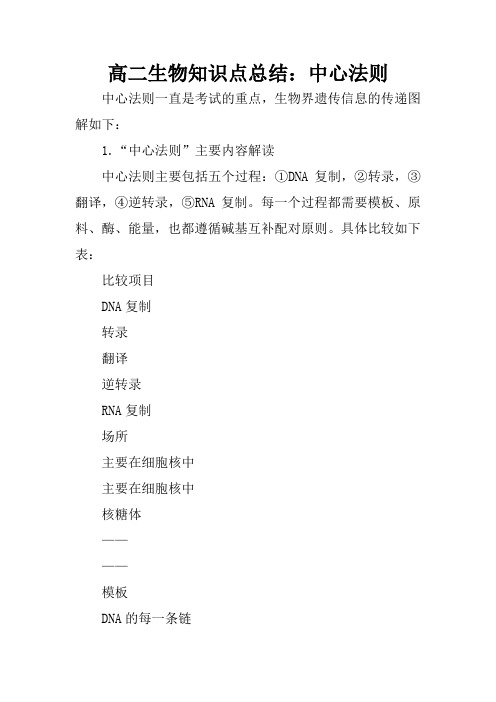
高二生物知识点总结:中心法则中心法则一直是考试的重点,生物界遗传信息的传递图解如下:1.“中心法则”主要内容解读中心法则主要包括五个过程:①DNA复制,②转录,③翻译,④逆转录,⑤RNA复制。
每一个过程都需要模板、原料、酶、能量,也都遵循碱基互补配对原则。
具体比较如下表:比较项目DNA复制转录翻译逆转录RNA复制场所主要在细胞核中主要在细胞核中核糖体————模板DNA的每一条链DNA的一条链mRNARNARNA原料4种脱氧核苷酸4种核糖核苷酸20种氨基酸4种脱氧核苷酸4种核糖核苷酸酶DNA解旋酶、DNA聚合酶、DNA连接酶等DNA解旋酶、RNA聚合酶等酶逆转录酶等RNA聚合酶等产物两个相同DNA分子mRNA蛋白质、水DNARNA能量ATP碱基互补配对原则G→c,c→GA→T,T→AA→U,T→AA→U,U→AA→T,U→AA→U,U→A工具————tRNA————实例乙肝病毒、动植物等绝大多数生物绝大多数生物艾滋病病毒甲型H1N1病毒等2.生物的遗传物质⑴以DNA为遗传物质的生物的遗传信息传递:DNA是自身复制和RNA合成的模板,RNA又是蛋白质合成的模板。
如动植物、原核生物、DNA病毒等⑵以RNA为遗传物质的生物的遗传信息传递:①实例:流感病毒、甲型H1N1流感病毒等②实例:艾滋病病毒3.典型考题赏析例1.请据图分析,下列相关叙述正确的是()A.①过程实现了遗传信息的传递和表达B.③过程只需要mRNA、氨基酸、核糖体、酶、ATP就能完成c.人的囊性纤维病体现了基因可通过控制蛋白质的结构直接控制生物体的性状D.图中只有①②过程发生碱基互补配对解析:通过DNA分子的复制,只是实现了遗传信息的传递,③翻译过程还需要特殊的运输工具—tRNA和适宜的外界条件,同时也发生了碱基互补配对。
本题错选的主要原因是对DNA复制、转录和翻译的过程理解不清。
答案:c例2.乙肝病毒是一种约由3200个脱氧核苷酸组成的双链DNA病毒,这种病毒的复制方式比较特殊,简要过程如下图所示。
分子生物学中心法则

大片段
(Klenow fragment)
5 ‘ →3 ’聚合功能, 3 ' →5 '外切酶活性
现在是14页\一共有45页\编辑于星期三
小片段
5 ' →3 '外切酶活性
引物酶(Primase)
DNA合成需在RNA引物的基础上进行。
5´ 3´
5´
3´
5´
5´
RNA引物
现在是15页\一共有45页\编辑于星期三
以15NH4Cl为唯一氮源培养大肠杆菌,连 续培养12代,使所有DNA标记上15N;
在普通培养基(14N)培养一代后,所有 DNA密度介于14N ~15N之间;
培养两代后, 14N和14N ~15N杂合分子等 量出现。
继续培养, 14N分子增多。
现在是4页\一共有45页\编辑于星期三
含15N-DNA的细菌 培养于普 通培养液
第一代 继续培养于 普通培养液
第二代
(深蓝: 15N) (粉红: 14N)
DNA半保留复制的证据
现在是5页\一共有45页\编辑于星期三
普通DNA 重DNA
中等密度DNA
普通DNA 中等密度DNA
现在是6页\一共有45页\编辑于星期三
现在是7页\一共有45页\编辑于星期三
核苷酸(dATP,dGTP,dCTP,dTTP,简写为 dNTP)聚合成DNA 这是一个非常复杂的酶促反应,需要许多 种酶和蛋白质参与。
不需ATP,切割双链DNA中的一链, 使DNA松弛后, 连接切口。
临床上使用的某些抗肿瘤药(如喜树碱等)是
通过抑制Topo酶活性而杀死肿瘤细胞的。
现在是19页\一共有45页\编辑于星期三
5、DNA连接酶-连接DNA片断的酶
分子生物学中心法则

分子生物学中心法则:DNA →RNA →蛋白质→细胞表性基因组中心法则:基因组→转录组→蛋白质组→细胞表性生物信息学是20世纪分子生物学和计算机科学交差结合产生的新的学科。
这个新的学科的焦点是使用计算机数据库和计算机算法来分析蛋白质、基因和构成生物体的全部脱氧核糖核酸。
生物信息学工具包括的计算机程序,可以用来帮助揭示与大分子的结构和功能、生化途径、疾病发生以及进化相关的生物学问题所内涵的基本机制。
如果两条序列有一个共同的进化祖先,那么他们是同源的。
同源性是序列同源或者不同源的一种论断,而一致性和相似性是一种描述序列相关性的量。
两个序列即使没有统计上显著的一致性,他们也可能是同源的。
同源性特征可分为直系同源(orthologous)和旁系同源(paralogous)。
直系同源序列是不同物种内的同源序列,他们来自于物种形成时的共同祖先基因。
直系同源基因被认为有相似的生物学功能。
旁系同源基因是通过类似基因复制的机制产生的同源序列。
可接受点突变PAM(accepted point mutation)为在蛋白质中被自然选择接受的耽搁氨基酸替换。
每种氨基酸在进化过程中发生突变的次数除以该氨基酸出现的总次数。
最常发生的替换是谷氨酸对天冬氨酸、丝氨酸对苏氨酸和异亮氨酸对缬氨酸。
突变概率矩阵M(mutation probability matrix)中元素M ij 表示在一个给定的进化时期内,氨基酸J替换成氨基酸I的概率。
进化时期为一个PAM(表示两个蛋白1%氨基酸发生变化的时间)。
当PAM=0时,矩阵讲成为单位矩阵,表示没有氨基酸发生变化。
当PAM相当大时,每行的所有值都接近于一个数值,这个数值就是氨基酸的出现频率。
块替换矩阵(block substitution matrix)BLOCSUM62矩阵是大多数BLAST算法的缺省矩阵。
PAM矩阵是基于近相关蛋白家族数据的。
并且假设高度相关蛋白的取代概率可以外推到远相关蛋白的概率。
分子生物学中心法则(二)2024
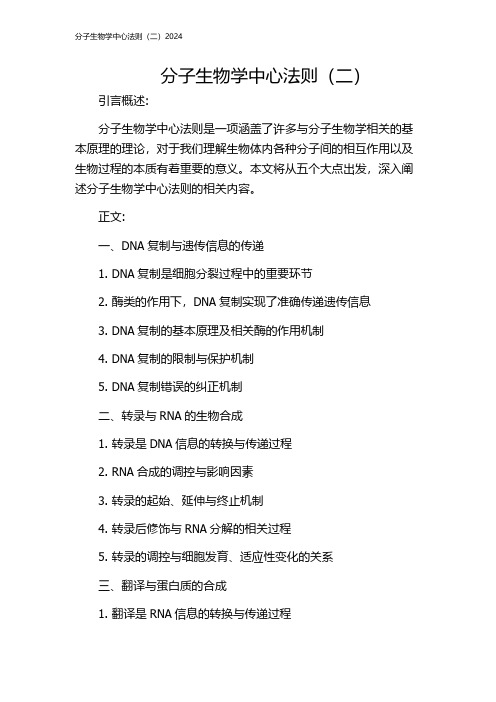
分子生物学中心法则(二)引言概述:分子生物学中心法则是一项涵盖了许多与分子生物学相关的基本原理的理论,对于我们理解生物体内各种分子间的相互作用以及生物过程的本质有着重要的意义。
本文将从五个大点出发,深入阐述分子生物学中心法则的相关内容。
正文:一、DNA复制与遗传信息的传递1. DNA复制是细胞分裂过程中的重要环节2. 酶类的作用下,DNA复制实现了准确传递遗传信息3. DNA复制的基本原理及相关酶的作用机制4. DNA复制的限制与保护机制5. DNA复制错误的纠正机制二、转录与RNA的生物合成1. 转录是DNA信息的转换与传递过程2. RNA合成的调控与影响因素3. 转录的起始、延伸与终止机制4. 转录后修饰与RNA分解的相关过程5. 转录的调控与细胞发育、适应性变化的关系三、翻译与蛋白质的合成1. 翻译是RNA信息的转换与传递过程2. tRNA与rRNA的角色与功能3. 翻译的起始、延伸与终止机制4. 翻译的调控与细胞过程的协调5. 蛋白质后修饰与功能调控的相互关系四、基因表达调控的机制1. 遗传密码的识别及转录调控的相关机制2. 染色质结构与DNA的可及性调控3. 转录因子与顺式作用元件的相互作用4. 转录后修饰的作用及影响机制5. 非编码RNA与基因表达调控的关系五、细胞凋亡与细胞周期的调控1. 细胞凋亡的调控机制及其与疾病的关系2. 细胞周期的调控及其与细胞增殖的关系3. 细胞生命信号的参与与调控过程4. 细胞周期调控与癌症的关联5. 药物干预与细胞凋亡与细胞周期调控之间的相互作用总结:分子生物学中心法则,作为现代生物学的重要理论之一,涵盖了DNA复制、RNA转录、蛋白质翻译、基因表达调控以及细胞过程等多个方面。
通过深入理解其原理和机制,我们能够更好地揭示生物体内分子之间的相互作用以及生物过程的本质。
这对于我们研究生命的奥秘以及促进相关领域的发展和应用具有重要的意义。
高二生物知识点总结:中心法则
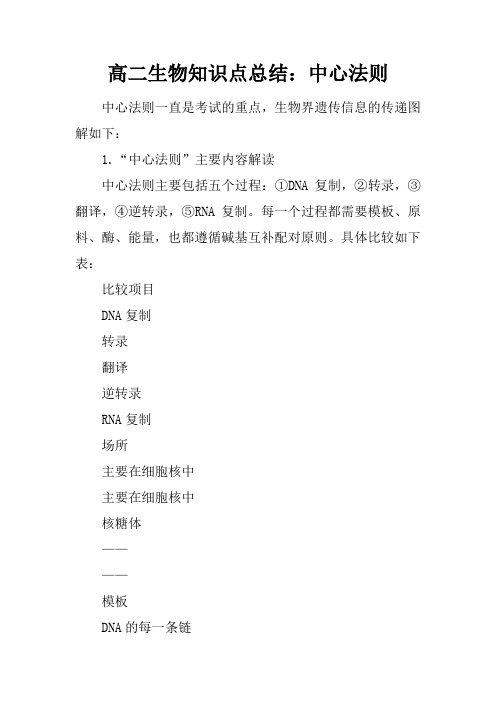
高二生物知识点总结:中心法则中心法则一直是考试的重点,生物界遗传信息的传递图解如下:1.“中心法则”主要内容解读中心法则主要包括五个过程:①DNA复制,②转录,③翻译,④逆转录,⑤RNA复制。
每一个过程都需要模板、原料、酶、能量,也都遵循碱基互补配对原则。
具体比较如下表:比较项目DNA复制转录翻译逆转录RNA复制场所主要在细胞核中主要在细胞核中核糖体————模板DNA的每一条链DNA的一条链mRNARNARNA原料4种脱氧核苷酸4种核糖核苷酸20种氨基酸4种脱氧核苷酸4种核糖核苷酸酶DNA解旋酶、DNA聚合酶、DNA连接酶等DNA解旋酶、RNA聚合酶等酶逆转录酶等RNA聚合酶等产物两个相同DNA分子mRNA蛋白质、水DNARNA能量ATP碱基互补配对原则G→c,c→GA→T,T→AA→U,T→AA→U,U→AA→T,U→AA→U,U→A工具————tRNA————实例乙肝病毒、动植物等绝大多数生物绝大多数生物艾滋病病毒甲型H1N1病毒等2.生物的遗传物质⑴以DNA为遗传物质的生物的遗传信息传递:DNA是自身复制和RNA合成的模板,RNA又是蛋白质合成的模板。
如动植物、原核生物、DNA病毒等⑵以RNA为遗传物质的生物的遗传信息传递:①实例:流感病毒、甲型H1N1流感病毒等②实例:艾滋病病毒3.典型考题赏析例1.请据图分析,下列相关叙述正确的是()A.①过程实现了遗传信息的传递和表达B.③过程只需要mRNA、氨基酸、核糖体、酶、ATP就能完成c.人的囊性纤维病体现了基因可通过控制蛋白质的结构直接控制生物体的性状D.图中只有①②过程发生碱基互补配对解析:通过DNA分子的复制,只是实现了遗传信息的传递,③翻译过程还需要特殊的运输工具—tRNA和适宜的外界条件,同时也发生了碱基互补配对。
本题错选的主要原因是对DNA复制、转录和翻译的过程理解不清。
答案:c例2.乙肝病毒是一种约由3200个脱氧核苷酸组成的双链DNA病毒,这种病毒的复制方式比较特殊,简要过程如下图所示。
生物化学中心法则的概念.doc
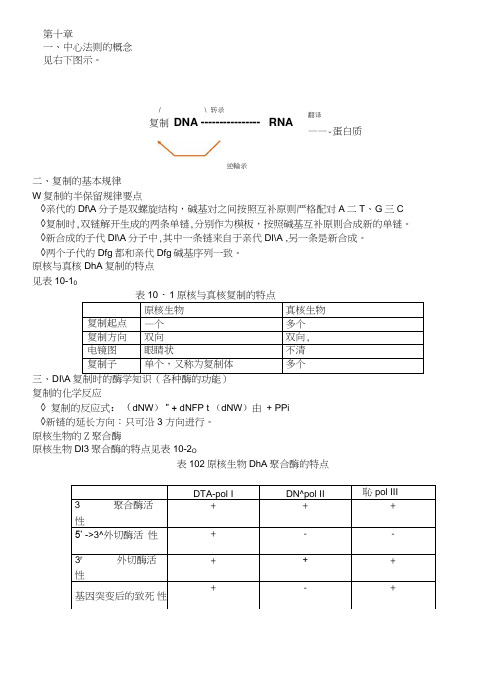
逆輪录二、复制的基本规律W复制的半保留规律要点◊亲代的Df\A分子是双螺旋结构,碱基对之间按照互补原则严格配对A二T、G三C ◊复制时,双链解开生成的两条单链,分别作为模板,按照碱基互补原则合成新的单链。
◊新合成的子代DI\A分子中,其中一条链来自于亲代DI\A ,另一条是新合成。
◊两个子代的Dfg都和亲代Dfg碱基序列一致。
原核与真核DhA复制的特点见表10-10表10・1原核与真核复制的特点原核生物真核生物复制起点—个多个复制方向双向双向,电镜图眼睛状不清复制子单个,又称为复制体多个三、DI\A复制时的酶学知识(各种酶的功能)复制的化学反应◊复制的反应式:(dNW)“ + dNFP t (dNW)由+ PPi◊新链的延长方向:只可沿3 方向进行。
原核生物的Z聚合酶原核生物DI3聚合酶的特点见表10-2O表102原核生物DhA聚合酶的特点DTA-pol I DN^pol II恥pol III3 聚合酶活性+ + + 5’ ->3^外切酶活性+ - -3r外切酶活性+ ++基因突变后的致死性+ - +第十章一、中心法则的概念见右下图示。
/ \ 转录复制DNA ---------------- RNA 翻译——-蛋白质真核生物DTS 聚合酶的特点 见表10-3O表10・3真核生物DhA 聚合酶的特点复制的保直性 ◊具看© 外切酶活性的酶是复制保真性的基础,原核生物主要是DhApol I,真核生物主要是DN^polE o◊ 错配出现的频率:d&dA > dA/dA >dC/dA◊复制保真性依赖的三种机制/遵守严格的碱基配对规律。
/聚合酶在复制中对碱基的选择作用。
/复制错误时有即时的校读功能。
原核生物复制起始的相关蛋白质 见表10・4。
表10・4原核生物复制起始的相关蛋白质DTS 拓扑异构酶的比较 见表10-5O表10・5 Df\A 拓扑异构酶的比较DhA连接酶记忆要点:◊连接Z链3'・CH末端和5’・P末端,生成磷酸二酯键。
- 1、下载文档前请自行甄别文档内容的完整性,平台不提供额外的编辑、内容补充、找答案等附加服务。
- 2、"仅部分预览"的文档,不可在线预览部分如存在完整性等问题,可反馈申请退款(可完整预览的文档不适用该条件!)。
- 3、如文档侵犯您的权益,请联系客服反馈,我们会尽快为您处理(人工客服工作时间:9:00-18:30)。
•
DNA的半不连续复制
Each replication fork has a leading and a lagging strand
leading strand (synthesized continuously)
replication fork
5’ 3’ 3’ 5’
5’ 3’ 3’ 5’
replication fork
Transcription,转录:以DNA为模板,按 碱基配对将其中所含的遗传信息传给RNA, 形成一条与DNA链互补的mRNA链的过程。
•
编码链,有义链 模板链,无义链
•
Transcription of a segment of DNA to form a molecule of RNA.
1)RNA聚合酶与DNA模板的结合
•
The sigma cycle• closed promoter complex (moderately stable)
s
• the sigma subunit binds to the -10 region
RNA polymerase holoenzyme (+ s factor)
• open promoter complex (highly stable)
•
2)起始
•
3)延长
•
4)终止
•
Transcription
closed promoter complex,封闭的启动子复合物
RNA polymerase,RNA聚合酶
open promoter complex,开放的启动子复合物
initiation
elongation
termination
RNA product •
Role
a
2
uncertain
b
1
forms phosphodiester bonds
b
1
binds DNA template
s
1
recognizes promoter and
facilitates initiation
a2bb’s
holoenzyme
a2bb’
+s
core polymerase sigma factor
• The small DNA pieces on the• lagging strand are called Okazaki fragments (100-1000 bases in length)
RNA primer
5’ 3’
direction of leading strand synthesis 3’ 5’
RNA chains are synthesized in a 5’ to 3’ direction
Prokaryotic RNA polymerase structure
RNA polymerase of E. coli is a multisubunit protein
Subunit
Number
•
•
二、DNA复制
•
DNA Replicating Itself
Replication,复制:在亲代 DNA双链的每一条链上按碱基 配对而准确地形成一条新的 互补链,结果生成两个与亲 代链相同的DNA双链。
•
DNA复制示意图
•
DNA的半保留复制
在DNA复制时,亲代DNA的双螺旋先解旋,然后以每条 链为模板,按照碱基配对原则,在这两条链上各形成一条 互补链。在每一个新形成的双螺旋中,一条链是从亲代 DNA来的,另一条是新形成的。
5’ 3’ 3’ 5’
lagging strand (synthesized discontinuously)
• The leading and lagging strand arrows show the direction of DNA chain elongation in a 5’ to 3’ direction
第三节 分子生物学的中心法则
The Central Dogma of Molecular Biology
•
1) 中心法则总述 2) DNA自我复制 3) 从DNA到RNA(转录) 4) 遗传密码 5) 从RNA到蛋白质(翻译) 6) 基因
•
一、中心法则简介
The Central Dogma of Molecular Biology
• sigma factor dissociates from the core polymerase after a few elongation reactions
s
• sigma can re-bind other core enzymes
• elongation takes place with the core RNA polymerase
•
四、遗传密码
The Genetic Code: Translation of RNA code into protein
•
三联体密码子的特点: 1)方向性 2)无标点性 3)简并性 4)通用性 5)摆动性
n fork
3’ 5’
direction of lagging strand synthesis
•
Movement of the replication fork
5’
3’
5’
3’
•
Movement of the replication fork
5’ RNA primer Okazaki fragment RNA primer
• the holoenzyme has very high affinity for
s
promoter regions because of sigma factor
• once initiation takes place, RNA polymerase does not need very high affinity for the promoter
•
复制体(replicon)
在DNA复制过程中,由众多 的酶和蛋白质参与DNA的复 制作用。
复制体的基本活动包括: 1)双链的解开; 2)RNA引物的合成; 3)DNA链的延长; 4)切除RNA引物,填补缺 口,连接DNA片段; 5)切除和修复错配碱基。
•
三、转录
Transcription: making an RNA copy of a DNA sequence
